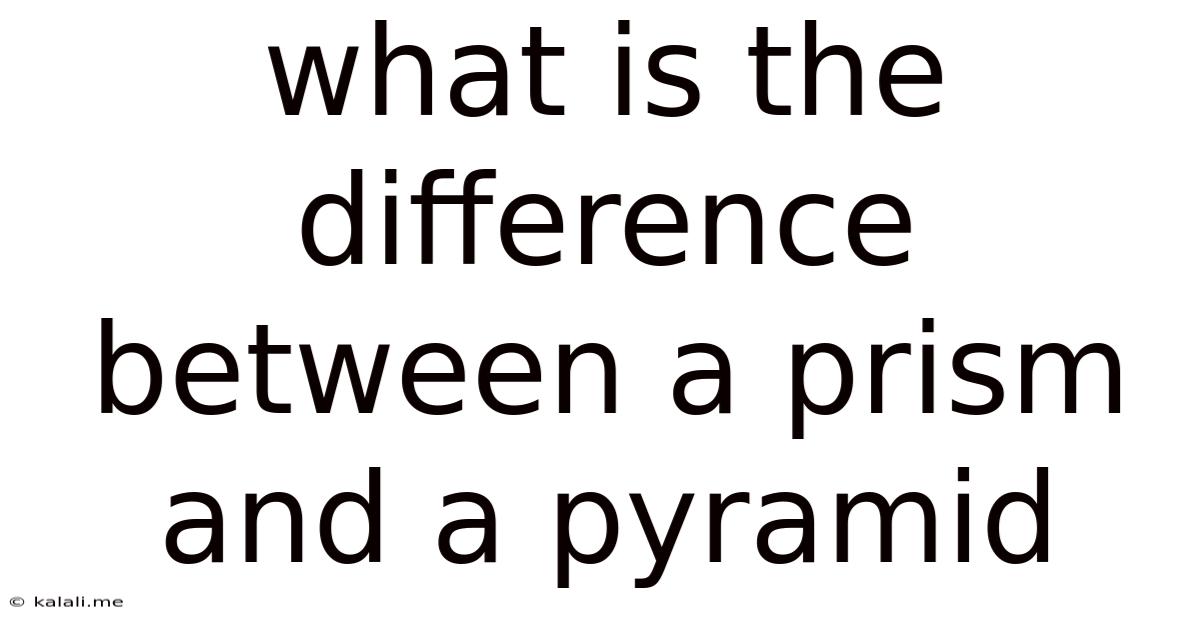What Is The Difference Between A Prism And A Pyramid
Kalali
Jun 11, 2025 · 3 min read

Table of Contents
Prisms vs. Pyramids: Understanding the Differences in Geometry
This article explores the key distinctions between prisms and pyramids, two fundamental three-dimensional shapes in geometry. Understanding their differences is crucial for anyone studying geometry, architecture, or even just appreciating the beauty of shapes in the world around us. We'll delve into their defining characteristics, explore their properties, and provide clear examples to solidify your understanding.
What is a Prism?
A prism is a three-dimensional geometric shape with two parallel and congruent polygonal bases connected by rectangular lateral faces. Think of it as a stack of identical shapes, one on top of the other. The shape of the base determines the type of prism. For example, a triangular prism has triangular bases, a rectangular prism (also known as a cuboid) has rectangular bases, and a pentagonal prism has pentagonal bases.
Key Characteristics of a Prism:
- Two congruent and parallel bases: These bases are identical in shape and size and lie on parallel planes.
- Lateral faces are parallelograms: The faces connecting the bases are parallelograms. In a right prism, these lateral faces are rectangles.
- Number of faces: The number of faces is equal to the number of sides of the base plus two (for the two bases).
- Number of edges: The number of edges is three times the number of sides of the base.
- Number of vertices: The number of vertices is twice the number of sides of the base.
What is a Pyramid?
A pyramid, in contrast to a prism, is a three-dimensional shape with a polygonal base and triangular lateral faces that meet at a single point called the apex. Imagine a cone, but instead of a circular base, it has a polygon as its base. Similar to prisms, the shape of the base dictates the type of pyramid. For instance, a triangular pyramid (also known as a tetrahedron) has a triangular base, a square pyramid has a square base, and so on.
Key Characteristics of a Pyramid:
- One polygonal base: This is the bottom face of the pyramid.
- Triangular lateral faces: These faces connect the base to the apex.
- Apex: A single point where all the triangular faces meet.
- Number of faces: The number of faces is equal to the number of sides of the base plus one.
- Number of edges: The number of edges is twice the number of sides of the base.
- Number of vertices: The number of vertices is equal to the number of sides of the base plus one.
Comparing Prisms and Pyramids: A Table Summary
| Feature | Prism | Pyramid |
|---|---|---|
| Bases | Two congruent and parallel bases | One polygonal base |
| Lateral Faces | Parallelograms (rectangles in right prisms) | Triangles |
| Apex | No apex | One apex |
| Shape | Elongated, often with uniform cross-section | Tapering towards the apex |
Examples in Real Life:
- Prisms: Many everyday objects are prisms, including boxes, books, some types of crystals, and even some buildings.
- Pyramids: The famous pyramids of Egypt are prime examples, as well as some types of tents and certain candies.
Understanding the distinctions between prisms and pyramids is fundamental to grasping spatial reasoning and the basics of three-dimensional geometry. By understanding their defining characteristics, you can confidently identify and differentiate these important geometric shapes.
Latest Posts
Latest Posts
-
How Old Am I If I Was Born In 1996
Jul 01, 2025
-
What Is 3 X 3 X 3
Jul 01, 2025
-
How Many Apples In A 3 Pound Bag
Jul 01, 2025
-
How Many Pounds Is A Bushel Of Peanuts
Jul 01, 2025
-
How Many Pounds Are In 32 Ounces
Jul 01, 2025
Related Post
Thank you for visiting our website which covers about What Is The Difference Between A Prism And A Pyramid . We hope the information provided has been useful to you. Feel free to contact us if you have any questions or need further assistance. See you next time and don't miss to bookmark.